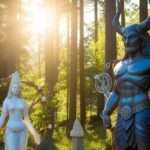Paganism and witchcraft have walked hand in hand through the corridors of time, influencing and shaping each other across centuries. Both practices draw from ancient spiritual traditions rooted in nature, the elements, and the divine feminine and masculine.
Understanding their shared history sheds light on how these spiritual paths have survived and thrived despite persecution and misunderstanding.
Ancient Roots of Paganism and Witchcraft

Paganism predates organized religion, tracing back to early human civilizations. The word “pagan” originally referred to rural dwellers who worshipped multiple gods and spirits tied to nature. Witchcraft, often seen as a natural extension of paganism, emerged as a practice of working with the energies of the earth, moon, and stars.
- Early pagans worshipped gods and goddesses representing natural forces like the sun, moon, and harvest.
- Witchcraft involved rituals, charms, and spells to honor these deities and harness natural energies.
Influence of Pagan Practices on Witchcraft
Many witchcraft traditions borrow directly from pagan practices:
- Herbalism – Using plants for healing and magical purposes.
- Divination – Tarot cards, scrying, and rune reading reflect ancient pagan methods of seeking guidance from the gods.
- Seasonal Festivals – Sabbats like Samhain, Yule, and Beltane stem from ancient pagan celebrations.
These practices were handed down through generations, blending pagan spirituality with witchcraft rituals.
Persecution and the Survival of Traditions
The rise of Christianity led to the persecution of pagans and witches:
- The witch trials of the Middle Ages saw countless women and men accused of heresy and devil worship.
- Pagan festivals were absorbed into Christian holidays, yet remnants of their original meanings persisted.
- Despite this, the core practices of both paganism and witchcraft survived underground.
Explore the history of witch trials.
The Modern Revival of Paganism and Witchcraft
The 20th century saw a resurgence of interest in pagan and witchcraft traditions:
- Wicca emerged as a structured form of witchcraft, heavily influenced by ancient pagan beliefs.
- Neo-Paganism incorporates various traditional practices from Celtic, Norse, and Greco-Roman origins.
- Modern witches and pagans celebrate the Wheel of the Year, honor nature spirits, and engage in spellwork and meditation.
This revival reflects a growing desire to reconnect with the natural world and ancient wisdom.
The shared path of paganism and witchcraft is one of resilience and transformation. Despite centuries of persecution, these spiritual practices have endured, offering a connection to nature, ancient wisdom, and personal empowerment.



